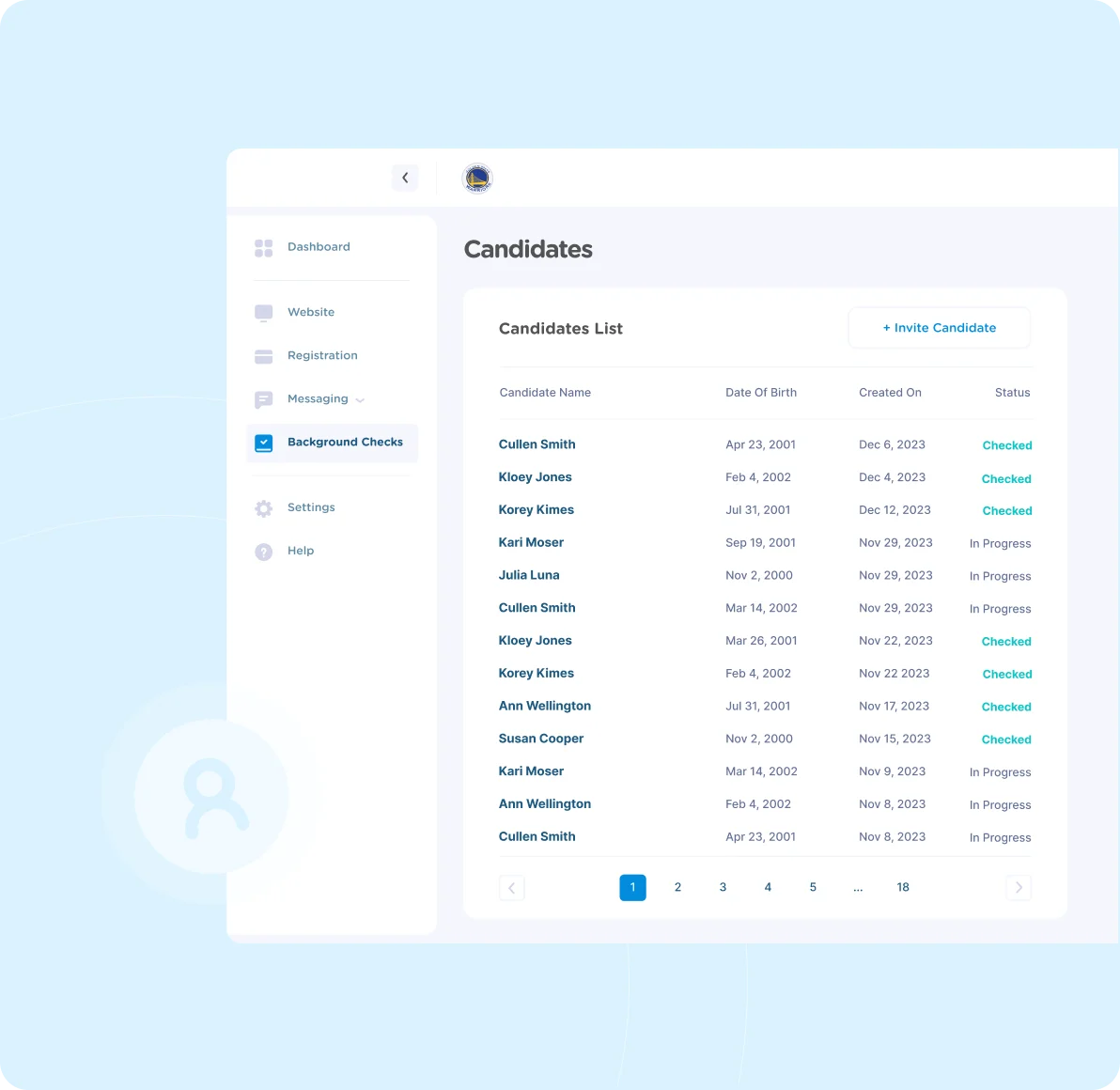
Table of Contents
According to a 2020 National Center of Health Statistics survey, 54% of 6-to 17-year-old children participated in youth sports within the last 12 months.
With more than half of the US youth population enrolled in sports, you likely know a child involved in athletics. But do you know the issues that children’s sports face every season?
This article will highlight the common issues in youth sports today and provide solutions for implementing positive change. Becoming knowledgeable about these issues will empower administrators, volunteers, coaches, and parents to become advocates for change for youth athletes.
9 top issues in youth sports (+ How to fix them)
Issue #1: Payment collection is complicated
Too often, providing flexibility and understanding during payment collection can cause more headaches for the volunteers involved. An example of this is allowing parents to choose how to pay during registration by offering a payment plan.
Although it may increase the number of participants and is a generous gesture, it can become an issue for your organization if your payment schedule is unclear, you forget to collect payments or parents don’t have a way to resolve missed installments.
To create a solution that both helps parents and simplifies the process for administrators, we’ve created the option for online payment plans. You set your installment prices and dates, and our system will automatically collect the payments from the card on file. As a bonus, we also remind parents to avoid failed payments!
Issue #2: Registering players is unorganized
Almost every organization’s goal is to have more participants than the previous year, but it’s not always possible for volunteers to manage this workload using their current methods. Outdated methods, such as paper registration forms, can lead to more work for administrators and parents. In recent times, such as during the pandemic, it was impossible to complete this task without modern solutions!
Moving your registration online allows parents to receive email receipts and pay using their credit or debit card. It also allows you to organize your participants’ information in one place.
You can also store past registration programs, duplicate programs for future use and export registration information. All of your information is stored within the organization to allow board members and volunteers to constantly change.
Issue #3: Scheduling has too many time conflicts
Scheduling conflicts may result in athletes dropping out of sports programs altogether due to the challenges of managing conflicting commitments.
High school athletes are managing more than ever with their education, a social life and school sports. With more to juggle, scheduling conflicts can lead to a decline in youth sports participation rates and potentially affect the viability of your youth sports program.
Having a dedicated area to post your events before the season starts can help with this. Updating the schedule on a week-by-week basis might not work for busy athletes and parents, so having this information posted in a timely manner is important!
Our scheduling feature allows you to create schedules and post individual events directly on your website’s homepage. You can link to a Google Calendar for the location, schedule multi-day events and even post results from games or tournaments.

Looking for more information on what to include on your sports website? Check out our blog post How to Build a Website for Youth Sports
Issue #4: Managing volunteers is overwhelming
Having many helping hands is crucial to running a successful youth sports organization, but managing volunteers can be tough. Since these will be adults working with adolescents, you’ll need to keep your athlete’s safety at the top of mind. The best way to ensure your young athletes are safe is by requiring background checks.
Background checks are relatively inexpensive, provide fast results and are a baseline decision-maker for allowing someone to join your organization.

Each organization has its own policy, but we recommend running checks each year, paying for candidates and enforcing checks to be on anyone who is in contact with the athletes, such as referees, coaches and volunteers.
You can create an account online to start running background checks for your organization!
Issue #5: There are too many teams to manage
If you’re a larger youth sports organization, chances are you have multiple teams to manage! For recreational organizations, teams can consist of different age groups, sports or genders. For more competitive programs, teams may be sorted by athletic ability. Although separating into smaller groups can be beneficial for a young athlete’s development, it can be a lot to handle for coaches and volunteers!
Jersey Watch is a sports team management platform that can help you better manage these moving parts.
Here are just a few ways we can help:
- Register by Age Group: If you divide athletes by age, you can duplicate your registration forms to quickly create individual forms for each age group. You can also easily move registrants between programs if a parent accidentally registers for the wrong age group.
- Create Team Rosters: If your team has high school athletes who may be recruited, you should have a dedicated spot to list out your individual team players. Our roster template includes their image, name, position and a brief bio to list their accomplishments.
- Create Separate Schedules: You can create different schedules for each team and post them to your website. This will help parents quickly find the sporting events that apply to their athletes.
Issue #6: Communicating with parents is difficult
Relying on Facebook or other social media platforms to communicate important information to youth sports parents isn’t sustainable or effective. Only posting to social media, where the feed’s algorithm constantly changes, can cause your messages to get lost. Parents have a lot on their plate, so you want to communicate organizational updates as quickly as possible.
To do this, you should communicate directly with your key contacts through emails and text messages since you know it will reach them. Our communication platform lets you send direct notifications to youth sports parents with just a few clicks.
Not sure how to improve your current communication process? Our blog post covers 5 ways to improve your organization through communication.
Issue #7: Parent expectations are too high
While it’s normal and expected for parents to want their children to succeed, having too high of expectations can have a negative impact on young athletes.
One of the impacts is increased pressure. This may cause a young athlete to focus on just a single sport, known as early specialization, even though they enjoy participating in various programs. A study by the Aspen Institute’s Project Play found that early sports specialization puts youth athletes at a higher risk of injury and can cause them to “retire” from sports.
Another impact is the relationship between the parent and the coach. If a parent feels their child isn’t getting enough playing time, this can cause tension, ultimately impacting your athlete. To proactively combat this, we recommend creating a Code of Conduct for Parents to set expectations early on!
Parents who focus too much on winning championships might see their attitude reflect on how their athlete views competition. Creating a culture of intense competition, especially between teammates, can foster poor sportsmanship and cause teamwork issues. Having a set of player guidelines listed on your website can show how your organization handles conflict.
Issue #8: Player safety isn’t a top priority
Keeping your athletes safe should be the top priority for your organization. You can take steps to ensure their physical and mental health are being cared for.
One way is to educate your coaching staff on concussion training. There are documents, videos and waivers about knowing the signs of a concussion and how to respond when a player has a head injury. You can use the online waivers during registration to even have parents acknowledge these forms.
Athletes can experience poor mental health related to burnout from too much pressure, an increase in practice or games and even from parental expectations. Having transparent information posted on your website will help with player expectations.
Sports-related injuries are prevalent in organized youth sports and some require a visit to your local pediatrics. Be sure to ask for an athlete’s medical information on your registration forms and don’t forget to have liability waivers acknowledged.
Issue #9: There is a lack of funding and resources
Funding your team sports program can be challenging, but there are ways to increase your revenue. Securing year-round sponsorships and making donations easy are just two ways to increase funding.
When you create a registration form with Jersey Watch, you’ll see there is an online donation feature. This allows for parents to optionally donate during registration. You can see a big impact with very little effort!
Final thoughts
We’re all trying to create a positive sports experience for young people and understanding common issues is a great place to start. When creating your own sports program, you should consider how your program will overcome these challenges. Using a sports management platform like Jersey Watch is a great way to put these solutions to the test!